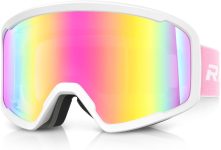
Christmas Ski/Snowboard Goggles for Men Women, OTG Ski Goggles Review – Oemiu
Christmas Ski & Snowboard Goggles: A Comprehensive Guide for Men and Women
The crisp mountain air, the exhilarating rush of gliding down a snowy slope, the sheer joy of winter – these are the experiences that draw us to the mountains every year. But the joy of skiing and snowboarding hinges on more than just skill and snow conditions. It hinges on clear, protected vision. Finding the perfect pair of ski goggles isn’t just a matter of style; it’s about safety, comfort, and maximizing your time on the slopes. As Christmas approaches and the ski season beckons, it’s time to think seriously about upgrading your eye protection, whether you’re a seasoned pro carving down black diamonds or a beginner navigating the bunny slopes. This guide will delve into the nuances of choosing the right ski and snowboard goggles, exploring the latest technologies, discussing fit and compatibility, and offering insights into maintaining your goggles for years of clear vision.
Understanding the Essentials: Lens Technology and VLT
The lens is arguably the most crucial component of any ski or snowboard goggle. It dictates how well you see in different light conditions, protects your eyes from harmful UV rays, and influences overall comfort. Understanding the different types of lenses and their specific applications is paramount to making an informed decision. One of the key aspects to consider is Visible Light Transmission (VLT). VLT refers to the percentage of light that passes through the lens and reaches your eyes. A higher VLT (e.g., 60-90%) is ideal for low-light conditions like overcast days or skiing in the trees, allowing more light to penetrate the lens and improve visibility. Conversely, a lower VLT (e.g., 5-20%) is best suited for bright, sunny days, reducing glare and preventing eye strain. Many modern goggles feature interchangeable lenses, allowing you to adapt to changing weather conditions throughout the day. Photochromic lenses, which automatically adjust their VLT based on ambient light, offer another convenient option, though they can be more expensive. Beyond VLT, consider the lens color. Amber, rose, and yellow lenses enhance contrast in low light, while gray, brown, and black lenses are better for bright conditions. Mirrored lenses reflect even more light, further reducing glare and improving visibility in sunny conditions. Lens shape also plays a role. Cylindrical lenses are curved horizontally but flat vertically, offering a wider field of view at a more affordable price. Spherical lenses, curved both horizontally and vertically, provide a more natural, distortion-free field of vision and often reduce glare. Ultimately, the best lens for you depends on your individual needs and the typical conditions you encounter on the slopes. Don’t underestimate the importance of UV protection either. Ensure that your goggles offer 100% UV protection to shield your eyes from the harmful effects of the sun’s rays, even on cloudy days. Quality ski goggles are an investment in your eye health and your overall enjoyment of the sport.
Lens Types and Their Applications
Diving deeper into lens types helps to narrow down the right choice for individual needs. Single-layer lenses are generally found on more budget-friendly goggles and are prone to fogging. Double-layer lenses create a thermal barrier, significantly reducing the likelihood of fogging by minimizing temperature differences between the inside and outside of the goggle. Tri-layer lenses, while less common, offer even greater fog resistance. In terms of lens technology, look for features like anti-fog coatings, which are crucial for maintaining clear vision, especially during high-intensity activity or in humid conditions. Some goggles even feature active ventilation systems that circulate air to further prevent fogging. Polarized lenses reduce glare from reflective surfaces like snow and ice, improving contrast and clarity, particularly on sunny days. However, polarized lenses can sometimes distort the appearance of ice, making it harder to spot potentially hazardous patches. Chromatic lenses are designed to enhance color perception and contrast, allowing you to see details more clearly in varying light conditions. These lenses often utilize specific tints and filters to optimize vision for specific environments. Photochromic lenses are the chameleons of the goggle world, automatically adjusting their tint based on the amount of ambient light. This versatility makes them a great option for skiers and snowboarders who encounter a range of conditions throughout the day, but they tend to be pricier than other options. Consider the specific technologies offered by different brands and choose lenses that align with your typical riding conditions and visual preferences. If you frequently ski in sunny, high-altitude environments, polarized lenses with a low VLT might be the best choice. If you prefer to ride in the trees or on overcast days, amber or rose-tinted lenses with a higher VLT could be more suitable. Ultimately, trying on different goggles and comparing their performance in different light conditions is the best way to determine which lenses work best for you. Remember to always clean your lenses with a soft, microfiber cloth specifically designed for goggles to avoid scratching or damaging the coating.
OTG (Over-The-Glasses) Compatibility: A Must-Have for Spectacle Wearers
For those who wear prescription glasses, finding ski goggles that fit comfortably over your glasses is paramount. OTG, or Over-The-Glasses, ski goggles are specifically designed to accommodate eyeglasses. These goggles feature a deeper frame and strategically placed cutouts in the foam to provide ample space for glasses without causing pressure or discomfort. Wearing regular ski goggles over glasses can result in several issues, including fogging, pressure on the temples, and a reduced field of vision. OTG goggles alleviate these problems, allowing you to enjoy clear vision and a comfortable fit. When choosing OTG goggles, make sure to measure the width and height of your glasses to ensure compatibility. Look for goggles that offer generous interior space and adjustable straps to accommodate different glasses sizes. Some OTG goggles even feature a special ventilation system to further reduce fogging when worn with glasses. It’s also worth considering the thickness of your glasses frames. Thicker frames may require larger OTG goggles to ensure a comfortable fit. Many ski shops allow you to try on goggles with your glasses to ensure compatibility before making a purchase. Alternatively, consider prescription inserts that clip into your goggles. These inserts provide clear vision without the need to wear glasses under your goggles. Prescription inserts can be a more streamlined and comfortable option for some spectacle wearers. Regardless of whether you choose OTG goggles or prescription inserts, ensuring clear vision is essential for safety and enjoyment on the slopes. Don’t compromise on comfort or clarity – invest in the right eyewear to make the most of your ski or snowboard experience. Poorly fitted goggles can lead to distractions, discomfort, and even accidents. Take the time to find the perfect fit and enjoy the slopes with confidence. A quality pair of Over The Glasses Ski Goggles will make all the difference.
Comfort and Fit: Securing Your Goggles for a Perfect Day on the Slopes
Comfort is paramount when it comes to choosing ski goggles. After all, you’ll be wearing them for hours on end, often in demanding conditions. A comfortable fit not only enhances your enjoyment but also contributes to your safety. The frame of the goggle should conform to the contours of your face without creating pressure points. Look for goggles with multi-density face foam that cushions your face and seals out the elements. The foam should be soft and breathable to prevent irritation and allow for proper ventilation. The adjustable strap should be wide and secure, allowing you to customize the fit and keep the goggles firmly in place, even during high-speed runs or unexpected falls. The strap should also be compatible with your helmet. Some goggles feature integrated helmet compatibility, with a shaped strap that conforms to the helmet’s curvature. When trying on goggles, wear your ski helmet to ensure a proper fit. The top of the goggles should sit flush against the helmet without leaving any gaps. The goggles should also not interfere with the helmet’s ventilation system. A secure and comfortable fit is essential for preventing the goggles from shifting or fogging up during your ski session. Consider the size and shape of your face when choosing goggles. Smaller faces may benefit from smaller frames, while larger faces may require larger frames. Women-specific goggles are often designed with a narrower fit and enhanced comfort features to accommodate female facial contours. Some goggles also feature adjustable nose bridges to further customize the fit. Pay attention to the ventilation system. Proper ventilation is crucial for preventing fogging and maintaining clear vision. Look for goggles with vents on the top, bottom, and sides of the frame. These vents allow air to circulate, reducing the build-up of moisture inside the goggle. Some goggles even feature adjustable vents that can be opened or closed to regulate airflow based on the weather conditions.
Helmet Compatibility: A Seamless Integration
The modern ski and snowboard experience is incomplete without a helmet. The integration between your helmet and goggles is crucial for both safety and comfort. Goggles that don’t fit well with your helmet can create gaps that expose your forehead to the cold and wind, leading to discomfort and potential frostbite. They can also interfere with the helmet’s ventilation system, causing fogging and reduced visibility. When choosing ski goggles, always bring your helmet to the store to ensure a proper fit. The goggles should sit flush against the helmet without any gaps or pressure points. The goggle strap should fit securely around the helmet without slipping or sliding. Some helmets feature a goggle clip that helps to keep the strap in place. Look for goggles that are designed to be compatible with a wide range of helmet brands and styles. Some goggles feature adjustable outriggers that allow you to customize the fit with different helmet shapes. Others feature a magnetic lens attachment system that allows you to quickly and easily swap lenses without removing your goggles from your helmet. Ventilation is also a key consideration when it comes to helmet compatibility. The goggles and helmet should work together to allow for proper airflow and prevent fogging. Make sure that the goggles don’t block the helmet’s vents, and that the helmet’s vents don’t direct cold air directly into the goggles. A seamless integration between your helmet and goggles will enhance your comfort, safety, and overall enjoyment on the slopes. Don’t underestimate the importance of trying on different combinations of helmets and goggles to find the perfect fit. A little extra effort in the beginning can make a big difference in your experience on the mountain. The right helmet and Snowboard Goggles combination can be life-changing.
Top Picks: Reviewing Popular Ski and Snowboard Goggle Models
Navigating the vast landscape of ski and snowboard goggles can be overwhelming. To simplify your decision-making process, let’s review some popular models known for their performance, comfort, and value. Note that prices can vary widely based on retailer, season, and specific features.
| Model | Lens Type | VLT Range | OTG Compatible | Key Features | Approximate Price |
|---|---|---|---|---|---|
| Oakley Line Miner | Prizm | 12-46% | Yes | Prizm lens technology, wide field of view, comfortable fit | $150 – $250 |
| Smith I/O MAG | ChromaPop | 9-65% | Yes | ChromaPop lens technology, magnetic lens change system, Fog-X anti-fog coating | $200 – $300 |
| Anon M4 | Perceive | 6-55% | Yes | Perceive lens technology, magnetic lens change system, MFI (Magnetic Facemask Integration) | $250 – $350 |
| Giro Axis | Vivid | 8-72% | Yes | Vivid lens technology, magnetic lens change system, EVAK Vent Technology | $180 – $280 |
| Dragon NFX2 | Lumalens | 15-55% | Yes | Lumalens lens technology, frameless design, armored venting | $160 – $260 |
These are just a few examples of the many excellent ski and snowboard goggles available on the market. When choosing a model, consider your specific needs and preferences, as well as your budget. Read reviews, compare features, and try on different goggles to find the perfect fit for you. The Oakley Line Miner is lauded for its wide field of view and comfortable fit, making it a great choice for all-mountain riding. The Smith I/O MAG stands out with its ChromaPop lens technology and magnetic lens change system, allowing for quick and easy lens swaps. The Anon M4 is known for its Perceive lens technology and MFI (Magnetic Facemask Integration), which seamlessly integrates with Anon facemasks. The Giro Axis boasts Vivid lens technology and EVAK Vent Technology for superior clarity and fog prevention. And the Dragon NFX2 features Lumalens lens technology, a frameless design, and armored venting for optimal performance. Each of these models offers a unique combination of features and benefits, so choose the one that best suits your individual needs and riding style. Remember to prioritize comfort, fit, and lens performance when making your decision. A well-chosen pair of ski goggles will enhance your vision, protect your eyes, and improve your overall experience on the slopes.
Caring for Your Goggles: Extending Their Lifespan
Proper care and maintenance are essential for extending the lifespan of your ski goggles and ensuring optimal performance. Always store your goggles in a protective case when not in use to prevent scratches and damage. Avoid storing them in direct sunlight or in extremely hot or cold environments, as this can damage the lens and frame. When cleaning your goggles, never use harsh chemicals or abrasive cleaners. Instead, use a soft, microfiber cloth specifically designed for cleaning lenses. Gently wipe the lens in a circular motion to remove dirt and smudges. Avoid rubbing the lens too hard, as this can scratch the anti-fog coating. If your goggles get wet, allow them to air dry completely before storing them. Do not use a hair dryer or other heat source to dry them, as this can damage the lens. After each use, inspect your goggles for any signs of damage, such as scratches, cracks, or loose parts. If you notice any damage, repair or replace your goggles as soon as possible. The goggle strap should also be cleaned regularly to remove sweat and dirt. You can wash the strap by hand with mild soap and water. Allow the strap to air dry completely before reattaching it to the goggles. Regularly check the ventilation system to ensure that it is clear of debris. Remove any snow or ice that may be blocking the vents. Proper ventilation is essential for preventing fogging and maintaining clear vision. By following these simple care and maintenance tips, you can keep your ski goggles in top condition and enjoy clear vision on the slopes for years to come. Remember that your goggles are an investment in your safety and enjoyment, so treat them with care. A little extra effort in maintaining your goggles can go a long way in extending their lifespan and ensuring optimal performance. Consider a dedicated goggle bag for storage and transport to further protect your investment. A sturdy bag will prevent scratches and impacts, keeping your goggles safe from damage.
Choosing the Right Christmas Ski & Snowboard Goggles: A Summary
Selecting the right ski or snowboard goggles involves carefully considering several factors. Prioritize lens technology, paying attention to VLT, lens color, and anti-fog coatings. Ensure a comfortable and secure fit, paying close attention to helmet compatibility and OTG requirements if you wear glasses. Finally, take the time to properly care for and maintain your goggles to extend their lifespan and ensure optimal performance. By following these guidelines, you can find the perfect pair of goggles to enhance your vision, protect your eyes, and elevate your experience on the slopes. With the right pair of Best Ski Goggles for Men and Women, you can be sure to have a great time on the slopes this Christmas.
Frequently Asked Questions
What is VLT and why is it important?
VLT stands for Visible Light Transmission. It’s the percentage of light that passes through a goggle lens and reaches your eyes. VLT is a critical factor in goggle selection because it directly impacts your vision in different light conditions. A higher VLT (e.g., 60-90%) is ideal for low-light situations like overcast days, foggy conditions, or skiing in wooded areas. These lenses allow more light to reach your eyes, improving visibility and contrast. Conversely, a lower VLT (e.g., 5-20%) is best suited for bright, sunny days. These lenses reduce the amount of light that reaches your eyes, minimizing glare and preventing eye strain. Choosing the right VLT for the prevailing conditions is crucial for clear vision, comfort, and safety on the slopes. Many goggles offer interchangeable lenses with different VLT ratings, allowing you to adapt to changing weather. Photochromic lenses offer the ultimate convenience, automatically adjusting their VLT based on ambient light levels.
How do I know if my ski goggles are OTG compatible?
OTG, or Over-The-Glasses, compatibility refers to a goggle’s ability to comfortably accommodate prescription eyeglasses. OTG goggles are designed with a deeper frame and strategically placed cutouts in the foam to provide ample space for glasses without causing pressure or discomfort. To determine if a goggle is OTG compatible, look for the “OTG” designation in the product description or specifications. You can also visually inspect the goggle’s frame and foam to see if it appears to have extra space for glasses. The best way to ensure OTG compatibility is to try on the goggles with your glasses at a ski shop or optician. This allows you to assess the fit and comfort firsthand. When trying on OTG goggles, make sure that your glasses fit comfortably inside the frame without pressing against your temples or nose. The goggles should also provide a secure seal around your face to prevent cold air and moisture from entering. If you wear glasses, OTG compatibility is a must-have feature for a comfortable and enjoyable ski or snowboard experience.
What are the benefits of polarized lenses?
Polarized lenses offer significant benefits for skiers and snowboarders, primarily by reducing glare from reflective surfaces like snow and ice. Glare can cause eye strain, fatigue, and reduced visibility, making it difficult to see bumps, ice patches, and other hazards on the slopes. Polarized lenses work by blocking horizontally polarized light, which is the type of light that is reflected off flat surfaces. This reduces the intensity of glare, improving contrast and clarity. With polarized lenses, you’ll be able to see details more clearly, even in bright, sunny conditions. This can enhance your performance, safety, and overall enjoyment on the slopes. However, it’s important to note that polarized lenses can sometimes distort the appearance of ice, making it harder to distinguish from snow. Some skiers and snowboarders prefer non-polarized lenses for this reason. Ultimately, the choice between polarized and non-polarized lenses depends on individual preferences and the specific conditions you encounter on the slopes.
How do I prevent my ski goggles from fogging?
Fogging is a common problem with ski goggles, but there are several steps you can take to prevent it. First, choose goggles with a double-layer or tri-layer lens. These lenses create a thermal barrier that reduces the temperature difference between the inside and outside of the goggle, minimizing fogging. Second, look for goggles with an anti-fog coating on the inside of the lens. This coating helps to absorb moisture and prevent condensation. Third, ensure that your goggles have adequate ventilation. Vents on the top, bottom, and sides of the frame allow air to circulate, reducing the build-up of moisture inside the goggle. Fourth, avoid touching the inside of the lens, as this can damage the anti-fog coating. Fifth, if your goggles do fog up, gently wipe the lens with a soft, microfiber cloth specifically designed for goggles. Avoid using harsh chemicals or abrasive cleaners. Finally, consider carrying a spare lens or a goggle dryer in case your goggles become excessively wet or foggy. By following these tips, you can minimize fogging and maintain clear vision on the slopes.
How do I clean my ski goggle lenses properly?
Cleaning your ski goggle lenses properly is crucial for maintaining clear vision and preventing damage to the anti-fog coating. Never use paper towels, tissues, or other abrasive materials to clean your lenses, as these can scratch the surface. Instead, use a soft, microfiber cloth specifically designed for cleaning lenses. Gently wipe the lens in a circular motion to remove dirt, smudges, and fingerprints. Avoid rubbing the lens too hard, as this can damage the anti-fog coating. If your lenses are particularly dirty, you can use a mild soap and water solution. Apply a small amount of the solution to the microfiber cloth and gently wipe the lens. Rinse the lens with clean water and allow it to air dry completely before storing it. Never use harsh chemicals or abrasive cleaners on your lenses, as these can damage the lens and void the warranty. Always store your goggles in a protective case when not in use to prevent scratches and damage. By following these cleaning instructions, you can keep your ski goggle lenses in top condition and enjoy clear vision on the slopes for years to come.
What is the difference between cylindrical and spherical lenses?
Cylindrical and spherical lenses are two common types of goggle lenses, each offering distinct advantages. Cylindrical lenses are curved horizontally but flat vertically. This design provides a wide field of view at a more affordable price point. However, cylindrical lenses can sometimes cause slight distortion, particularly at the edges of the field of view. Spherical lenses, on the other hand, are curved both horizontally and vertically. This design provides a more natural, distortion-free field of vision, mimicking the curvature of the human eye. Spherical lenses also tend to reduce glare and improve depth perception. However, spherical lenses are typically more expensive than cylindrical lenses. The choice between cylindrical and spherical lenses depends on your budget, visual preferences, and the importance you place on distortion-free vision. If you’re on a tight budget, cylindrical lenses may be a good option. If you prioritize optimal vision and are willing to spend more, spherical lenses are the better choice. Ultimately, trying on different goggles with both types of lenses is the best way to determine which one works best for you.
How do I choose the right goggle size for my face?
Choosing the right goggle size is crucial for comfort, fit, and performance. Goggles that are too small may create pressure points and restrict your field of vision, while goggles that are too large may not seal properly and allow cold air and moisture to enter. To determine the right goggle size for your face, consider the following factors. First, measure the width of your face from temple to temple. This will give you a general idea of the size goggle you need. Second, try on different goggles at a ski shop or optician. The goggles should fit snugly against your face without creating any pressure points. The foam should conform to the contours of your face and create a secure seal. Third, consider the size and shape of your nose. Some goggles feature adjustable nose bridges to accommodate different nose shapes. Fourth, if you wear glasses, make sure that the goggles are OTG compatible and provide ample space for your glasses without causing pressure or discomfort. Finally, wear your ski helmet when trying on goggles to ensure a proper fit and compatibility. The top of the goggles should sit flush against the helmet without leaving any gaps. By following these guidelines, you can choose the right goggle size for your face and enjoy a comfortable and secure fit on the slopes. This will ensure clear vision, protection from the elements, and an overall more enjoyable ski or snowboard experience. Don’t underestimate the importance of proper sizing – it’s a critical factor in goggle performance.


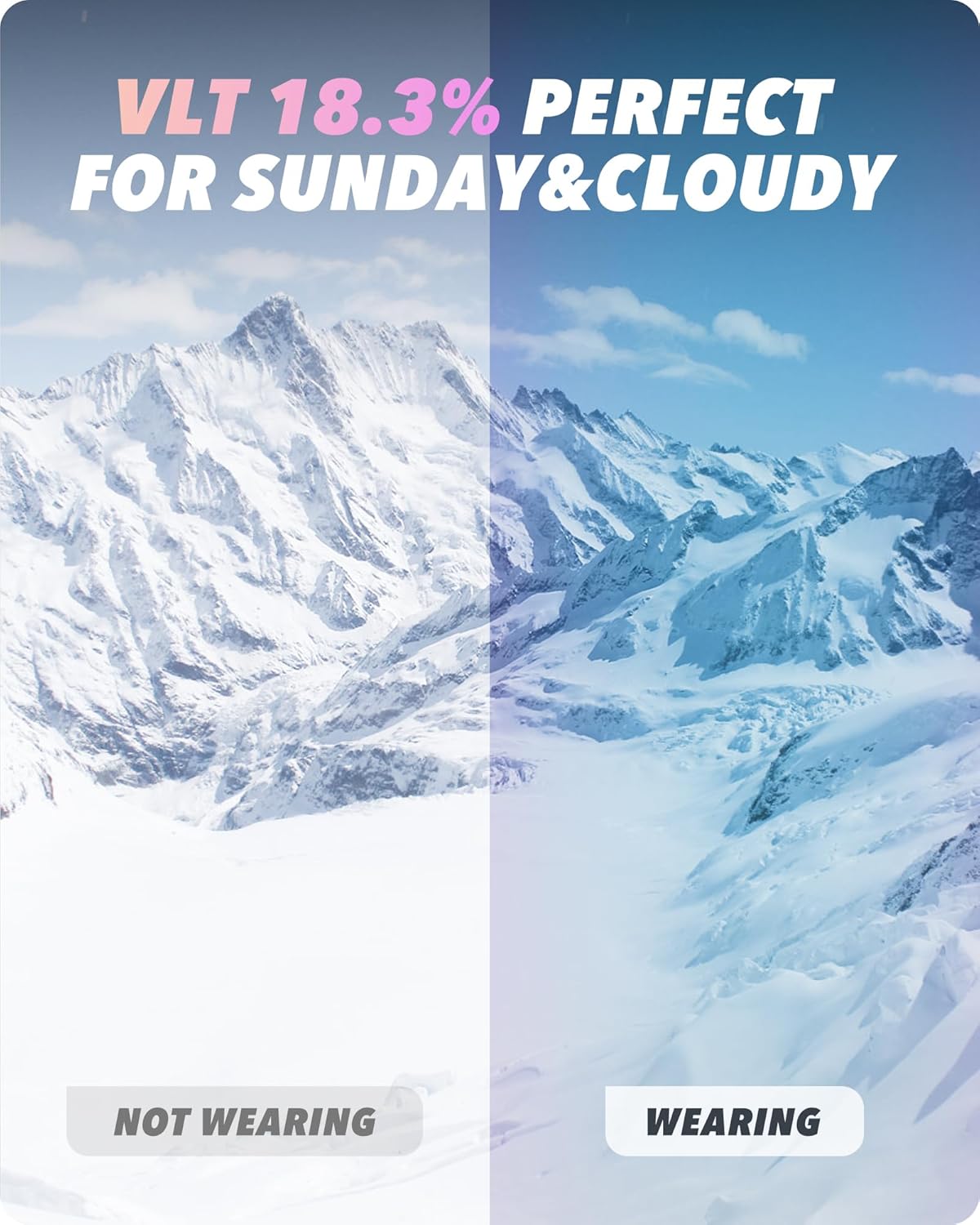
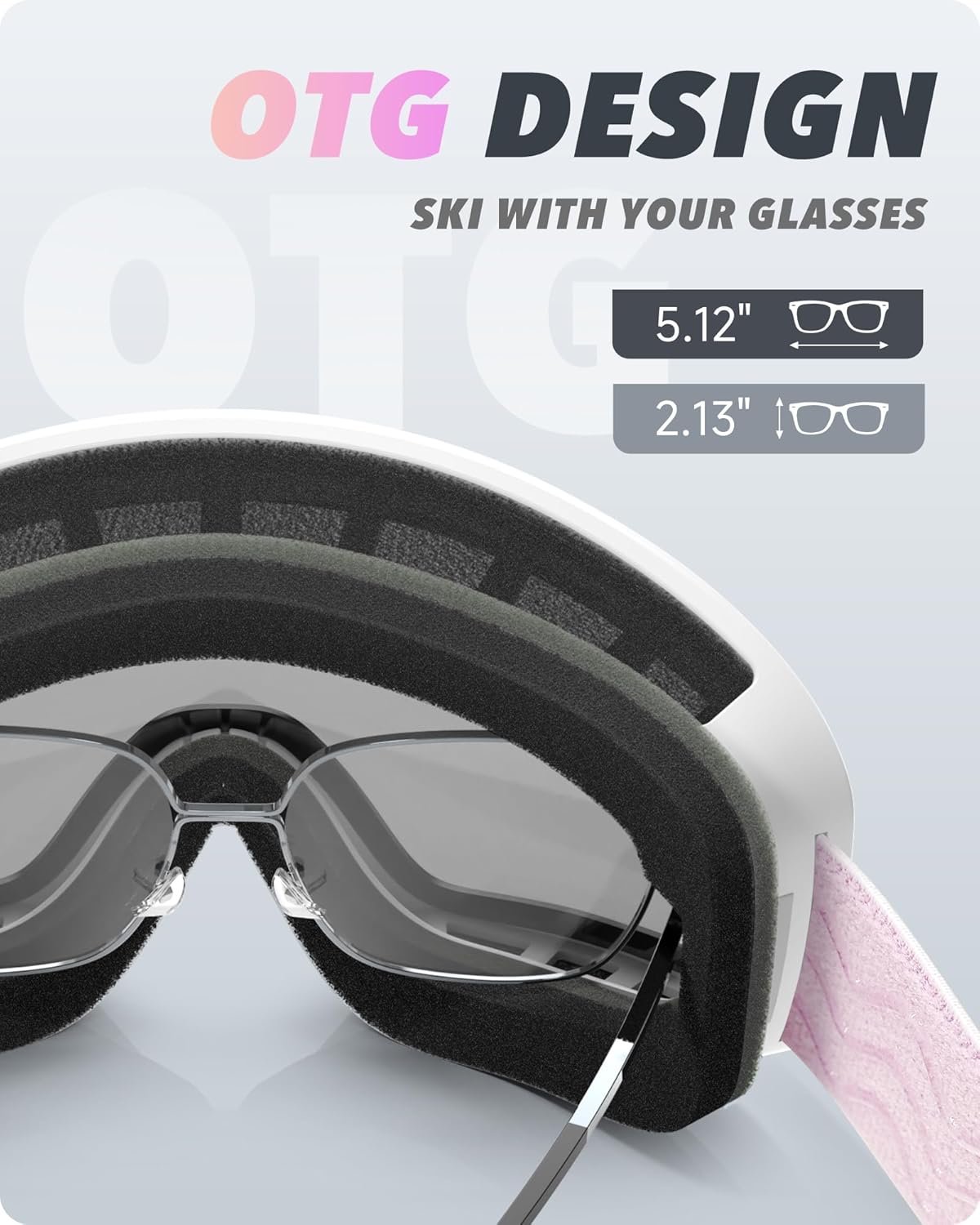
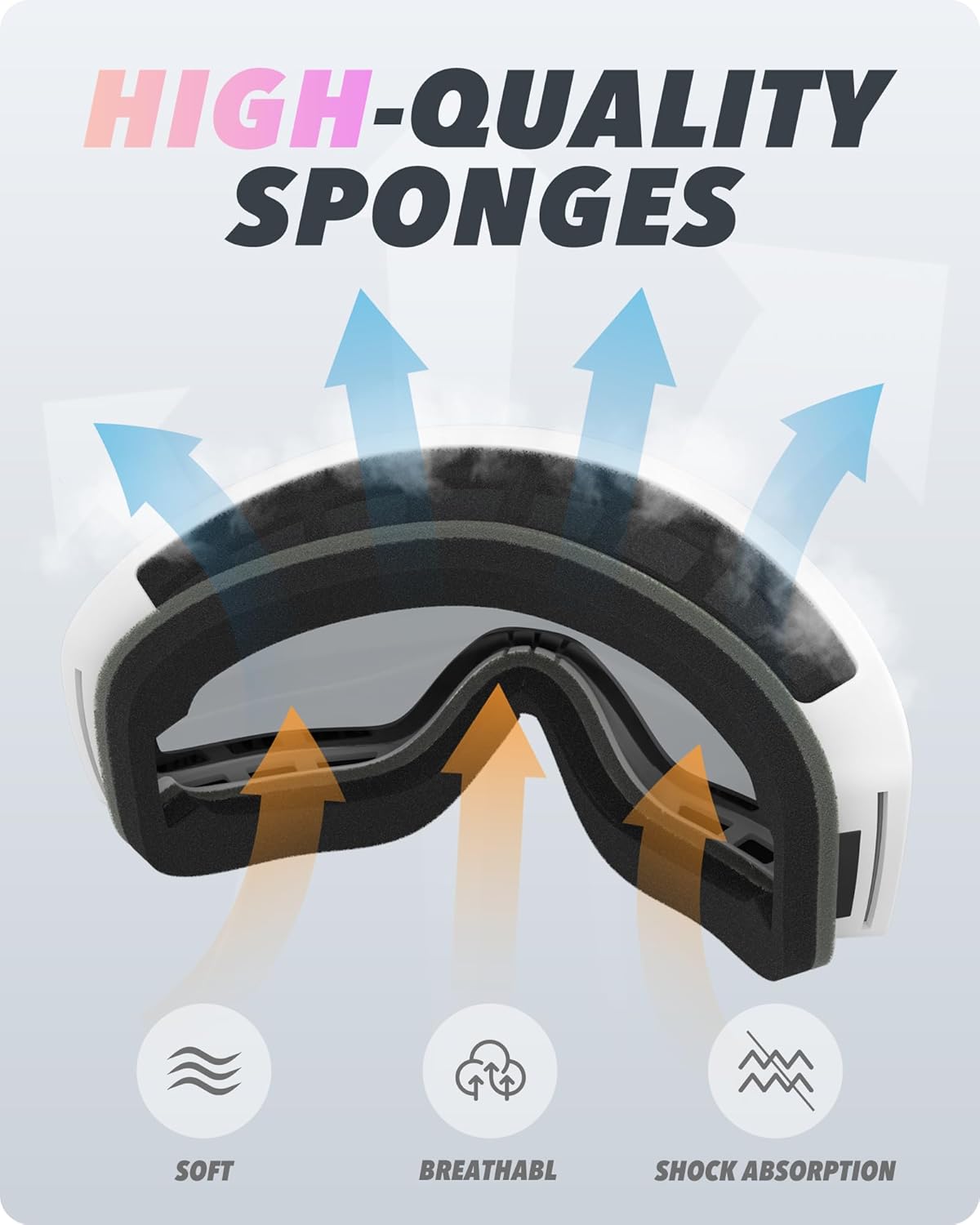
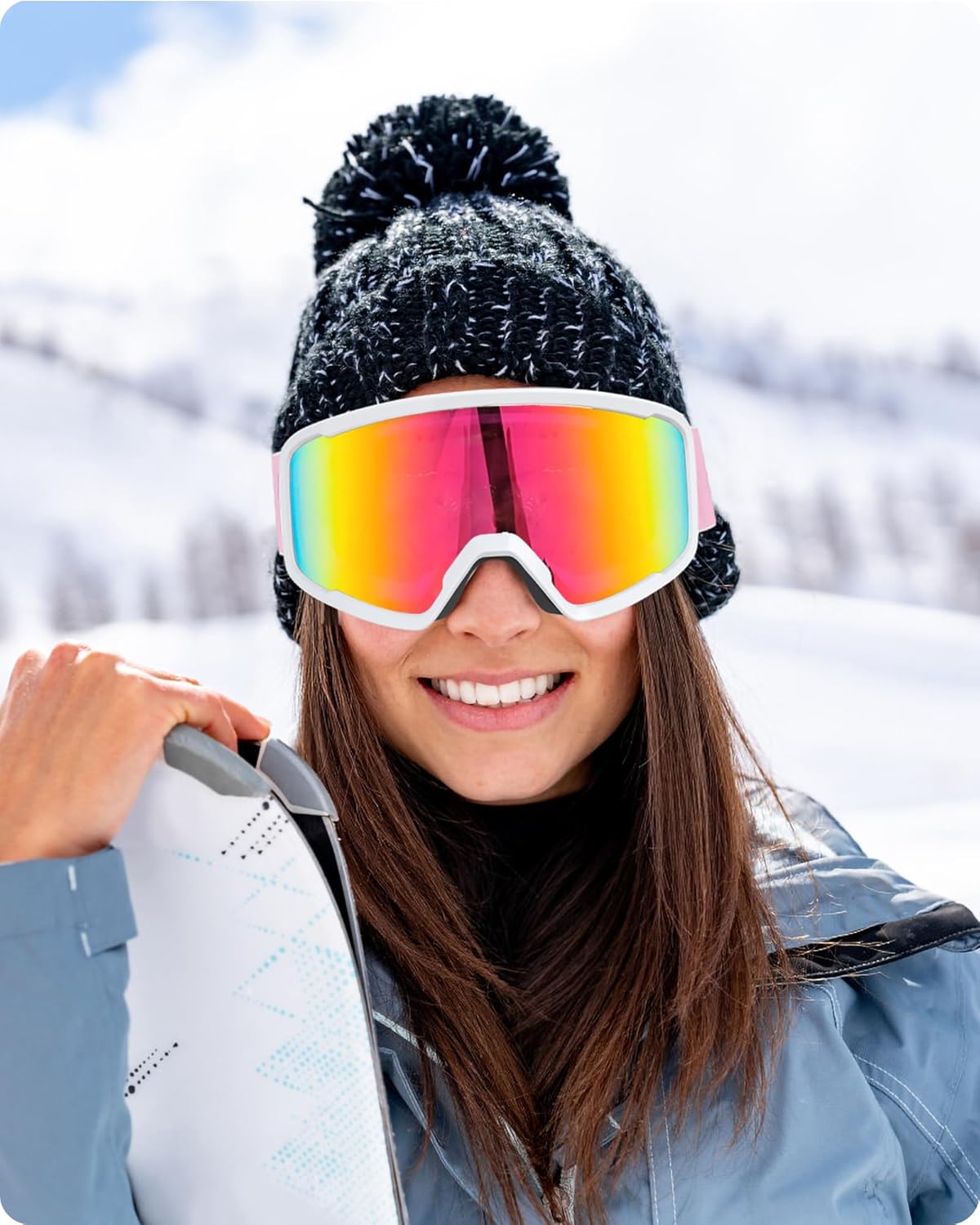
Price: $25.99 - $23.99
(as of Sep 06, 2025 03:26:41 UTC – Details)




